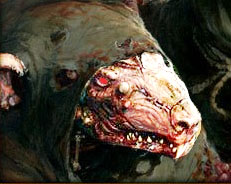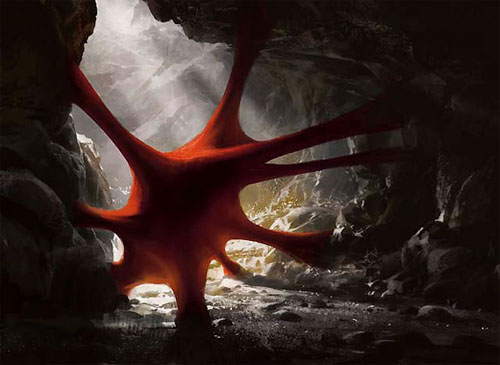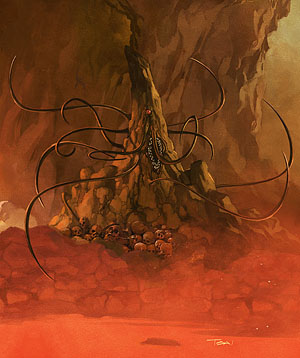Last week I posted a rant about the difficulty of creating lycanthropic stat blocks in 3rd Edition. The short version is this: Creating lycanthropes require you to create three separate stat blocks simultaneously while pulling information from both the base creature and the animal form. You end up juggling five stat blocks and if you discover that you need (or want) to make an adjustment on any one of them during the creation process you have to backtrack the change through all the other stat blocks.
I concluded that the rules themselves weren’t necessarily bad, but the organization of the rules were unnecessarily convoluted. It would be easier if the rules presented a clear order of progression:
(1) Create a stat block for the base creature.
(2) Apply the lycanthrope template in order to create the stat block for the humanoid form.
(3) Apply the hybrid template to the humanoid form in order to create the stat block for the hybrid form.
(4) Apply the animal form template to the humanoid form in order to create the stat block for the animal form.
And to that end I created sample templates for the wererat, which turned the rant into something rather more useful. Noumenon liked the template enough that he asked me to turn it into a series. I was initially skeptical that just churning out templates would be particularly interesting blog material, but then I realized I could spice things up a little by providing some advanced lycanthrope characters as sample applications of the templates.
So, on that note: Welcome to Movies & Lycanthropes Week at the Alexandrian.
Today is a bit of a rehash as we return to the wererat templates (although the sample NPC is new), but tomorrow we’ll have completely new material.
Note: These templates are designed to create 100% rules-accurate stat blocks. In other words, applying these templates should give you the exact same stat blocks that you would get if you applied the template from the 3.5 core rulebooks. They’re just providing a cleaner, quicker way of getting there.
WERERAT TEMPLATES
WERERAT TEMPLATE
Apply this template to the base creature to create the wererat’s humanoid form. This template can be added to any humanoid or giant.
Size and Type: Creature gains the “shapechanger” subtype.
Hit Dice and Hit Points: Add 1d8 hit die to the base creature.
Armor Class: +2 bonus to natural armor.
Special Qualities: alternate form, lycanthropic empathy, low-light vision, scent
Base Save Bonuses: Fort +2, Ref +2, Will +2
Abilities: Wis +2, may gain an ability score increase due to additional hit dice
Skills: +8 racial bonus on Climb and Swim checks. Gains (2 + Int modifier) skill points, treating Climb, Hide, Listen, Move Silently, Spot and Swim as class skills.
Feats: Alertness, Iron Will, Weapon Finesse
Challenge Rating: +2
WERERAT HYBRID TEMPLATE
Apply this template to the wererat’s humanoid form to create the stat block for its hybrid form.
Size and Type: Small or the size of the base creature, whichever is larger.
Armor Class: +1 bonus to natural armor (if better than the base creature’s natural armor bonus)
Attacks: Gains 2 claw attacks and 1 bite as a secondary attack (-5 penalty).
| Hybrid Size | ||
|---|---|---|
| Small | ||
| Medium | ||
| Large | ||
| Huge |
Special Attacks: curse of lycanthropy (Fort DC 15); cannot cast spells with verbal components
Special Qualities: DR 5/silver for afflicted lycanthropes; DR 10/silver for natural lycanthropes
Abilities: Dex +6, Con +2
WERERAT ANIMAL FORM TEMPLATE
Apply this template to the wererat’s humanoid form to create the stat block for its animal form.
Size and Type: Small
Speed: 40 ft., climb 20 ft.
Armor Class: +1 natural armor (if better than the base creature’s natural armor)
Attacks: Replace all attacks with a bite attack (1d4 plus disease).
Special Attacks: curse of lycanthropy (Fort DC 15); cannot cast spells with verbal, somatic, or material components
Special Qualities: DR 5/silver for afflicted lycanthropes; DR 10/silver for natural lycanthropes
Abilities: Dex +6, Con +2
Skills: Can choose to take 10 on Climb checks even if rushed or threatened. Can use their Dex modifier for Climb and Swim checks.
BRADOCH THE WERERAT
Bradoch is an elderly, orcish wererat. He has been isolated from his tribe and his kind of decades now. His only companions are his faithful rats, who surround him in great hordes throughout the forest. Bradoch is intensely protective of the rats, and he hates the goblin tribes (who hunt them for food).
Note: Bradoch is currently unschooled in the common tongue. But if he is brought into frequent interaction with local human populations, he will make it a point to learn it as quickly as possible — either relying on his own interaction or falling back onto using his rats as spies.
BRADOCH – ORC FORM (CR 6) – Barbarian 4 – NE Medium Humanoid (Orc, Shapechanger)
DETECTION – darkvision 60 ft., low-light vision, scent, Listen +11, Spot +11; Init +2; Languages Orcish
DEFENSES – AC 19 (+1 Dex, +2 natural, +6 +1 mithril chainmail), touch 11, flat-footed 18; hp 26 (4d12+1d8-5); Weakness light sensitivity
ACTIONS – Spd 40 ft.; Melee quarterstaff +7 (1d6+2); Ranged dart +5 (1d4+2 and poison); Space 5 ft.; Reach 5 ft.; Base Atk +4; Grapple +6; Atk Options rage 2/day; Combat Gear third eye of the rat
SQ alternate form, darkvision 60 ft., fast movement, illiteracy, light sensitivity, low-light vision, lycanthropic empathy, rage 2/day, scent, trap sense +1, uncanny dodge
STR 14, DEX 12, CON 8, INT 14, WIS 17, CHA 13
FORT +5, REF +4, WILL +8
FEATS: Alertness, Iron Will, Stealthy, Weapon Finesse
SKILLS: Climb +11, Handle Animal +7, Hide +10, Intimidate +4, Jump +8, Listen +11, Move Silently +10, Spot +11, Swim +10
POSSESSIONS: +1 mithril chainmail, masterwork quarterstaff, 6 poisoned darts, third eye of the rat, ruby (240 gp, worn on cord around his neck)
BRADOCH – HYBRID FORM (CR 6) – Barbarian 4 – NE Medium Humanoid (Orc, Shapechanger)
DETECTION – darkvision 60 ft., low-light vision, scent, Listen +11, Spot +11; Init +2; Languages Orcish
DEFENSES – AC 23 (+4 Dex, +3 natural, +6 +1 mithril chainmail), touch 14, flat-footed 19; hp 31 (4d12+1d8); DR 10/silver; Weakness light sensitivity
ACTIONS – Spd 40 ft.; Melee quarterstaff +6 (1d6+2) or 2 claws +8 (1d4+2) and 1 bite +3 (1d6+1 and lycanthropy); Ranged dart +8 (1d4+2 and poison); Space 5 ft.; Reach 5 ft.; Base Atk +4; Grapple +6; Atk Options rage 2/day; SA curse of lycanthropy; Combat Gear third eye of the rat
SQ alternate form, darkvision 60 ft., fast movement, illiteracy, light sensitivity, low-light vision, lycanthropic empathy, rage 2/day, scent, trap sense +1, uncanny dodge
STR 14, DEX 18, CON 10, INT 14, WIS 17, CHA 13
FORT +5, REF +7, WILL +8
FEATS: Alertness, Iron Will, Stealthy, Weapon Finesse
SKILLS: Climb +11, Handle Animal +7, Hide +14, Intimidate +4, Jump +8, Listen +11, Move Silently +14, Spot +11, Swim +10
POSSESSIONS: +1 mithril chainmail, masterwork quarterstaff, 6 poisoned darts, third eye of the rat, ruby (240 gp, worn on cord around his neck)
BRADOCH – DIRE RAT FORM (CR 6) – Barbarian 4 – NE Small Humanoid (Orc, Shapechanger)
DETECTION – darkvision 60 ft., low-light vision, scent, Listen +11, Spot +11; Init +2; Languages Orcish
DEFENSES – AC 24 (+4 Dex, +1 size, +3 natural, +6 +1 mithril chainmail), touch 15, flat-footed 20; hp 31 (4d12+1d8); DR 10/silver; Weakness light sensitivity
ACTIONS – Spd 50 ft., climb 20 ft.; Melee bite +8 (1d4, disease, lycanthropy); Space 5 ft.; Reach 5 ft.; Base Atk +4; Grapple +2; Atk Options rage 2/day; SA curse of lycanthropy, disease; Combat Gear third eye of the rat
SQ alternate form, darkvision 60 ft., fast movement, illiteracy, light sensitivity, low-light vision, lycanthropic empathy, rage 2/day, scent, trap sense +1, uncanny dodge
STR 14, DEX 18, CON 10, INT 14, WIS 17, CHA 13
FORT +5, REF +7, WILL +8
FEATS: Alertness, Iron Will, Stealthy, Weapon Finesse
SKILLS: Climb +13*, Handle Animal +7, Hide +18, Intimidate +4, Jump +8, Listen +11, Move Silently +14, Spot +11, Swim +12*
POSSESSIONS: +1 mithril chainmail, masterwork quarterstaff, 6 poisoned darts, third eye of the rat, ruby (240 gp, worn on cord around his neck)
Alternate Form (Su): Switch forms as standard action.
Curse of Lycanthropy (Su): Fort DC 15
Disease: Filth Fever (Fort DC 10, incubation 1d3 days, damage 1d3 Dex + 1d3 Con)
Light Sensitivity (Ex): Dazzled in bright sunlight or daylight spell.
Lycanthropic Empathy (Ex): Communicate with rats and dire rats; +4 bonus on Charisma-based checks against them.
Poison (Ex): Medium spider venom (injury DC 14, 1d4 Str/1d4 Str)
Rage (Ex): 5 rounds: +4 Str, +4 Con, +2 Will saves, -2 AC. Cannot use Concentration; Cha, Dex, or Int skills. Fatigued when rage ends (-2 Str, -2 Dex, can’t charge or run).
Scent (Ex): Detect presence within 30 feet (60 feet upwind, 15 feet downwind). Strong scents at double that range; overpowering at triple. Detect direction as move action. Pinpoint within 5 feet.
Trap Sense (Ex): +1 on AC and Reflex saves vs. traps.
Uncanny Dodge (Ex): Retains Dex bonus to AC when flat-footed.
*Skills: Can choose to take 10 on Climb checks even if rushed or threatened.
THIRD EYE OF THE RAT
Price (Item Level): 18,000 gp (6th)
Body Slot: Head
Caster Level: 6th
Aura: Moderate
Activation: —
Weight: —
This rat’s eye suspended in amber can be placed upon the forehead, where it will automatically attach itself as a third eye. A character using the eye can automatically detect the presence of any rat within 300 feet. In addition, they can attune themselves to a rat of their choice within that range as a standard action and see through the eyes of the rat.
The third eye of the rat does not grant the wearer the ability to control the rats in any way, but if the wearer looks through the eyes of a rat that they control which is currently sharing their space then they cannot be flanked.
Prerequisites: Craft Wondrous Item, clairvoyance, detect animals or plants
Cost to Create: 9,000 gp + 720 XP
CONCLUSION
Bradoch is fairly straight-forward: I created a 4th-level Barbarian with elite stats, applied the old age template, and then applied the wererat template. I’m showcasing him here because my struggles with Bradoch led directly to the creation of these lycanthropic templates (so it seemed appropriate).
Bradoch is also a secret sneak peek at a super secret project that I’m currently developing. The project is still so far under wraps the only thing I can tell you about it is a hint wrapped inside an enigma:
There is now a hidden way to access the homepage of the Alexandrian. But that is not its ultimate goal.
Have fun speculating! More were-creatures tomorrow!
This material is covered by the Open Gaming License.















